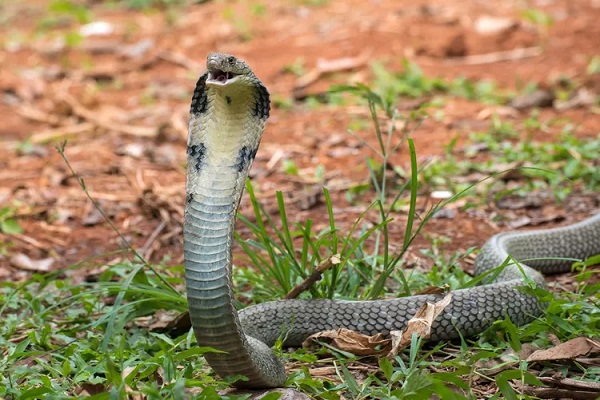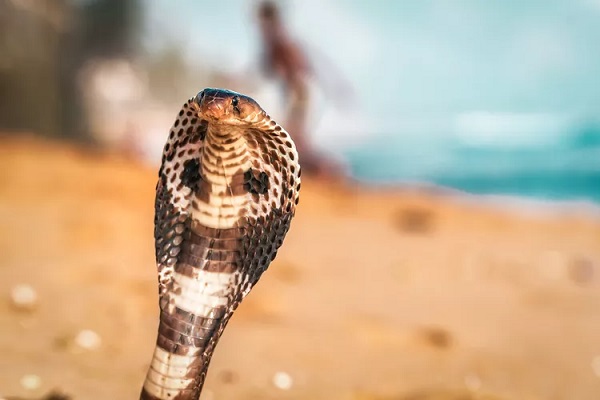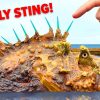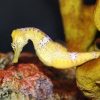
The deadly king cobra is the longest of all venomous snakes and easily claims the title of “king”: this powerful reptile feeds mostly on other snakes and often lives for decades in the wild, as there are few other animals that can kill this kind of snake. Found mostly in the rain-forests and swamps of Asia, king cobras prefer habitats with thick vegetation, such as bamboo and mangrove thickets.
Here are eight facts that will offer insight into the mysterious and intriguing world of the king cobra.
1. The King Cobra Is the Longest of Venomous Snakes
There are hundreds of species of venomous snakes in the animal kingdom, but the king cobra is the longest of them all. An adult snake can be 10 to 12 feet long and weigh up to 20 pounds. When a cobra “stands,” it can be eye to eye with a human of average height. The longest king cobra on record measured at 18 feet. As a comparison, the python, the longest non-venomous snake, can grow 20 feet long.
2. King Cobra’s ‘Hoods’ Are Actually Ribs

When a king cobra is on the defense, it produces a distinctive hood that flares around its face. This hood, like other parts of the snake’s body, has markings unique to the king cobra. At first glance, the snake’s hood looks like part of its skin, but it’s actually a system of rib bones and muscles that can flex and move. To make itself appear larger and more dangerous, the king cobra spreads these ribs and fans out the hood as it hisses and “stands” up.
3. Their Venom Is a Deadly Neurotoxin
Poisonous snakes are generally divided into two venom classifications: neurotoxic and hemotoxic. A neurotoxin is any poison directly affecting a human’s or animal’s nervous system. Hemotoxins, on the other hand, are typically found in rattlesnakes and vipers and affect a human’s or animal’s bloodstream. A king cobra’s venom is neurotoxic—when the snake strikes, it produces a small amount (mere ounces). Even this small amount can send the snake’s prey into paralysis. Moreover, this venom is so poisonous that a human can die within minutes of being bitten. A large animal—such as an elephant—can die in a few hours.
4. King Cobras Are Cannibals
King Cobras are considered cannibalistic because they generally only eat other snakes. Occasionally, they may eat a small animal, rodent, or bird, but that’s more characteristic of a common cobra. Cobras’ stomachs have adapted with digestive juices to break down other snakes’ poison and render it safe, so even if another snake is venomous, the king cobra isn’t affected. Since king cobras don’t have any teeth, they eat their prey whole. The cobra’s jaws can stretch and open wide to allow large animals to pass through, although it may take several minutes for them to swallow an animal entirely.
Cobras can go months, even years, without eating, like several other snakes. Snakes don’t need to drink water to survive, but they’ll absorb it through their bellies as they pass through naturally wet areas, such as streams, marshes, and creek beds.
5. Female Cobras Make Nests
The king cobra is the only snake that builds a nest. When a female cobra prepares to lay her eggs, usually in the spring, she creates a nest of leaves and twigs. The female builds walls and a cover to insulate and protect the eggs she’ll lay (she lays a clutch, or a group of eggs, which can be as many as 50 eggs). A female cobra remains in the nest, on guard, for several months until the eggs hatch. From the start, hatchings can care for themselves and even bite if necessary. It takes about four years for a king cobra to reach maturity from the hatchling state.
6. The Mongoose is Their Biggest Predator
As powerful as the king cobra is, the mongoose is the one animal it will avoid crossing paths with. This small mammal, a member of the Herpestidae family, is only about a foot long but immune to many snakes’ venom. As a carnivore, the mongoose normally eats small rodents, like rats, but has been known to fight and kill venomous snakes. The mongoose won’t hunt or track a cobra intentionally but will defend itself if threatened.
7. They Use Sound to Defend Themselves
Even though king cobras can swim quickly and climb trees, they are still prone to attacks from other reptiles and animals. When king cobras are on alert, they use multiple defense tactics to protect themselves. Most of the time, they would rather get away than fight and can move as fast as 12 mph. However, if cornered, in addition to flaring their hood to make themselves appear bigger, they also make a unique moan. Like most snakes, cobras will hiss, but they also use this moan to signal to their predators to back away before they strike. By filling their lungs and slowly exhaling, they emit a long, low-pitched noise like a dog growl. Unfortunately, the king cobra’s greatest predator is the human.
8. King Cobras Have Long Lifespans
In the wild, these snakes can live for more than two decades. Since they can survive for long periods without eating and don’t require much water, they aren’t overly susceptible to droughts, food scarcity, or other natural disasters in the same way that other animals and reptiles might be. Also, not many other animals that live in the areas that cobras inhabit hunt these snakes, so they have very little danger of becoming prey.
Despite their privileged position in the food chain, king cobras are categorized as vulnerable by the International Union for Conservation of Nature (IUCN), threatened mostly by habitat destruction and human persecution.
You May Like Also on Afribeats:



